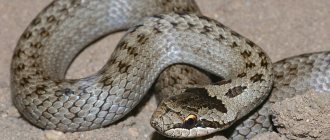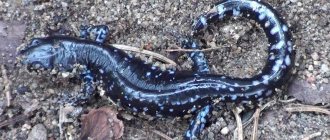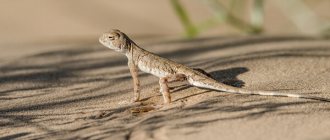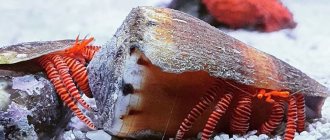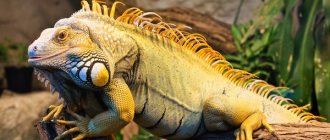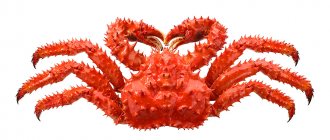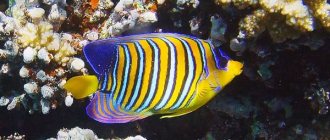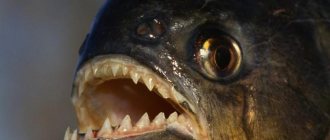- Reptiles
California king snake
(
Lampropeltis zonata
) - Non-venomous snake of the colubridae family (
Calubridae
). Today there are about fourteen species, the main habitat of which is North and Central America, as well as Mexico.
Appearance and description of king snakes
The king snake received its second name “sparkling shield” due to the presence of very specific dorsal scales. The king snake was nicknamed because in the wild, other types of snakes, including poisonous ones, became its favorite treat. This feature is due to the lack of sensitivity of the king snake’s body to the poisons of its relatives.
This is interesting! There are documented cases in which members of the kingsnake genus ate the most dangerous rattlesnakes.
Currently, only seven subspecies belonging to the genus of king snakes have been studied quite well. All types have significant differences not only in color, but also in size. Body length can vary from 0.8 m to one and a half to two meters. As a rule, the scales of snakes of this genus are smooth, have a bright and contrasting color, and the main pattern is represented by numerous multi-colored rings. The most common combination is represented by red, black and white.
Why are milk snakes unusual?
When you first look at these snakes, the thought immediately comes to you: why are they “milk”, because their colors are very bright? The snake has a bright scarlet color, and its body is surrounded by yellow and black rings.
The Sinaloyan kingsnake, using mimicry, is very similar to the poisonous coral adder.
The thing is that in places where milk snakes live, cattle may lose milk for some reason. American farmers believe that someone is sucking this milk. And the culprit was quickly found - a brightly colored snake often found in pastures. This is where its name comes from.
Interestingly, many city residents also think that snakes love milk and lap it up from a saucer. If you do not give the snake water, it will indeed drink milk, but this will only cause intestinal upset.
When getting to know these snakes, a second question also arises: since they have such a bright color, do they mean they are poisonous? No, this is a manifestation of mimicry; milk snakes, due to their coloring, imitate poisonous coral snakes.
Main types
Let's look at several main types of these snakes.
California king snake
What it looks like. Slender and muscular body 0.6–1 m long. There are red spots on the slightly elongated head with a blunt muzzle. The body is decorated with a pattern in the form of alternating rings - black and white. Most often, the black rings are divided into two parts by a red stripe, which sometimes closes on the stomach. Some subspecies do not have a red tint in color. The upper part of the head is black with a light transverse stripe or lateral spots.
Where he lives. Distributed from the north of the California Peninsula (Mexico) to the southern part of Oregon (USA), including all of California. A separate group is observed in the south of the American state of Washington. Prefers mountainous terrain.
What does it eat? Rodents, lizards, snakes, birds, eggs.
Did you know? According to the Guinness Book of Records, the world's largest reptile, an 18-year-old python named Fluffy, lives at the Ohio State Zoo (USA). This record holder is more than 7 meters long and weighs as much as 136 kg!
Striated
What it looks like. The length reaches 1.3 meters. The coloration is reminiscent of poisonous coral adders and is a combination of rich shades of red, black and white.
Where he lives. North America (from Colombia to Canada).
- German Shepherd
- What kind of snakes are kept at home?
- Ancient dog breeds
- Dog's sense of smell
- Maine Coon
- Domestic iguana
What does it eat? Small lizards, various amphibians and large insects.
Common kingsnake
What it looks like. The average length is 1–1.4 m, the maximum reaches 2 m. A triangular head is located on the slender body. It is painted brown or black with light transverse stripes in the form of an elongated chain. The abdomen is dark in color with a pattern of several light stripes.
Where he lives. Starting from southern New Jersey to northern Florida (USA). Prefers to settle in deciduous and coniferous plantations, meadows, and swampy areas.
What does it eat? Small lizards, snakes. Find out which snakes are the largest and which are the most beautiful.
Mexican black
What does it look like ? The average length is 0.9–1 m, but can reach up to 2 m. The slightly elongated head is flattened on both sides. The muscular gray or brown body is decorated with irregular patches of red or black and red with a light border. The head is marked with a dark pattern resembling the letter "U". Gray belly, sometimes red coloring at the bottom of the tail.
Where he lives. Northwestern Mexico and the US state of Texas. Likes to settle in dry rocky places.
What does it eat? Small lizards, rodents and snakes.
Arizona
What it looks like. The length ranges from 50 to 100 cm. Slender body with a compact and slightly rounded head. The top of the head is almost black, the tip of the nose is light, and there are red areas above the eye sockets. The body is covered with a pattern of red, black and light stripes. The back is black, on the stomach there is a pattern in the form of uneven areas of red, black and yellow.
Where he lives. Central and southeastern Arizona (USA), through northern Mexico to Chihuahua and Sonora. More often it lives in the mountains, among coniferous plantations, and loves rocky soil.
What does it eat? Lizards and rodents. Important! The king snake quickly gets used to its owner, becomes almost tame and does not show any aggression. At the same time, you should accustom your pet to handling hands gradually, starting with 5-10 minutes of communication a day.
Campbell's king milk snake
What it looks like. The length reaches 0.9 m. The color looks like alternating red, black and white stripes. The head is dark, the first light stripe extends to the temple and sometimes reaches almost to the tip of the muzzle. The dark stripes are much thinner than the red and white ones; in some representatives of the species the red color is almost absent.
Where does it live ? Mexico. Settles in mountain valleys, forests, and floodplains.
What does it eat? Small rodents, lizards, snakes. Familiarize yourself with the features of keeping a milk snake in a terrarium.
Mountain
What it looks like. The average length is 0.8–0.9 m, the maximum length is 1.5 m. A strong muscular body is crowned with a pointed head. Its shade is black, steel or gray. The snake's coloration is a dark gray background with wide, saddle-shaped orange areas.
Where he lives. Southern territories of Texas and New Mexico (USA), Mexican province of Chihuahua. Settles in rocks and forests.
What does it eat? Lizards, mice, amphibians.
Beautiful king snake
What it looks like. The length reaches 0.75–1 m. The strong body ends with a slightly elongated head, flattened on both sides. Background color - from fawn to brown. The pattern is red or brown rectangular spots located across the body. The abdomen has a beige or yellowish tint with dark areas. There are specimens of red and pink color without dark colors.
Where he lives. Central and southeastern United States from Texas to Florida and North Carolina. Settles in prairies, open forests, and forest clearings.
What does it eat? Rodents, frogs, birds, snakes.
Did you know ? Despite its small head measuring only 1 centimeter, the African snake can swallow an egg 5-6 times larger. This is helped by the special structure of the snake’s lower jaw, which can diverge to accommodate large prey. As soon as the egg is inside, special vertebrae open the shell, and the reptile regurgitates its pieces out.
Cobra in culture
It is interesting that a respectful attitude towards cobras was formed precisely where the largest and most poisonous species live - in India and Egypt. The fact is that the inhabitants of these countries, who inevitably shared a common territory with cobras, have studied their customs well and know that these snakes are predictable, calm, and therefore harmless. For a long time, there has been a unique profession of snake charmer. It was mastered by subtle observers who knew how to handle snakes in such a way that their defensive reaction never turned into aggression. Cobras were carried in baskets or jugs, after opening which the caster began to play the pipe and the snake seemed to come out to the call and dance to the music.
Cobra and Shiva
In fact, cobras, like all snakes, are deaf, but they react to the measured swaying of the pipe and track this “enemy” with their gaze; from the outside it looks like a dance. With skillful handling, the spellcasters could dull the snake’s attention so much that they allowed themselves to kiss the snake; less skillful masters preferred not to take risks and removed the poisonous teeth of the cobras. However, contrary to what most people believe, tooth extraction surgery was not common. Firstly, a cobra, deprived of poison, is unable not only to catch, but also to digest its prey, which means it is doomed to a slow death of starvation. Changing snakes every couple of months is an extra hassle for the poor street vagabonds. Secondly, spectators could demand from the owner that he demonstrate the poisonous teeth of the cobra, and then the swindler would face shameful expulsion and lack of money. Only Indian and Egyptian cobras have learned to tame.
In addition, in India, cobras often settled in temples; unlike living quarters, no one drove them out of here. Cobras not only personified wisdom and were an object of worship, but also performed the unspoken function of guards. Night thieves, coveting treasures, had every chance of being bitten by a snake in the dark. History also knows more sophisticated ways of “using” cobras. They were often planted in the homes of unwanted people, whom they wanted to deal with without publicity or trial. It is reliably known that the legendary Egyptian queen Cleopatra took her own life with the help of a cobra. Nowadays, cobras still pose a danger to humans. True, this danger is caused not so much by the snakes themselves, but by the overpopulation of some regions - there are almost no places left in nature where cobras could hide from humans.
Cobra on Tutankhamun's mask
Such proximity often turns into “conflicts”; up to a thousand people die every year from cobra bites in India (to a lesser extent in Africa). On the other hand, there is an antidote against cobra venom, which is prepared in serpentariums. Cobra venom is also a valuable raw material for the production of a number of medical products. To do this, snakes are caught and “milked”; one individual can produce several portions of poison, but its life in captivity is short-lived, so these reptiles need protection. Thus, the Central Asian cobra is listed in the International Red Book.
The habits of cobras and their relationship with mongooses were described very accurately by Rudyard Kipling in the story “Rikki-Tikki-Tavi”.
MILK SNAKE: DESCRIPTION, CARE, REPRODUCTION, PHOTO, TYPES
MAISE SNEAKER: MAINTENANCE AND CARE AT HOME, PHOTO
RED-EARED TURTLE: CONTENT, BREEDING, DESCRIPTION, FEEDING, PHOTO, VIDEO, CARE
Area
It lives in North America, in the USA - California, Nevada, Arizona, and also in Mexico.
A terrestrial species, it prefers to settle in forests, meadows, mountain slopes, fields, as well as on the outskirts of towns and cities. Swims well and easily climbs trees and bushes.
It is characterized by high ecological plasticity and inhabits a wide range of biotopes, from sand dunes on the sea coast, as well as forests, bushes and prairies, to deserts and rocky beds of dry rivers. The mountains rise to 2164 m above sea level (in the Sierra Nevada). It is also found in anthropogenic landscapes: along the edges of fields, near roads, in farm yards, in vacant lots and in construction waste dumps.
In the north of the range and in the mountains they are active from April to October, and in the south throughout the year. Like many other species of snakes, seasonal changes in daily activity have been described - in hot weather they are nocturnal, and in spring and autumn they are often found on the surface during the day. It winters in caves, deep burrows of various animals and other underground shelters, where the temperature does not fall below zero. They dig holes themselves extremely rarely. There are known cases of joint wintering of a large number of individuals and wintering with snakes of other species.
Subspecies of milk snakes
The milk snake Lttriangulum is a northern subspecies; unlike its relatives, it is not striped, but spotted. Its color is similar to that of the corn snake. Her back is gray or light brown, and along it runs a chain of red or brown spots with a black edging.
King snakes have smooth scales and are predominantly colored in combinations of red, black and white.
No less interesting is the subspecies Ltgaigeae from Panama and Costa Rica. The young animals have a classic color - red-striped, but six months later and after 7 molts, it becomes velvety black with greenish tints.
The most elegant among milk snakes are representatives of the subspecies Ltcambelli with a contrasting black-red-white color and representatives of the subspecies Ltsinaloae with wide scarlet pepper rings.
Honduran milk snakes L. t. hondurensis are less bright compared to the Mexican ones, but they are larger in size. The eggs hatch into babies reaching a length of 32 centimeters, so they can immediately feed on the pubescent mice.
These subspecies of milk snakes are most often found in terrariums. They are best suited for hobbyists.
Milk snakes live in coniferous forests, shrubby woodlands, meadows, semi-deserts, sea coasts, and mountains.
Behavior of the California Kingsnake
Snakes are active from late March to early November. In winter, they go deep into rock crevices or hide in mammal burrows, in a state close to suspended animation, although some individuals crawl out to bask on warm stones if the winter is mild.
In spring and autumn it is active during the day; in summer, the California kingsnake hunts at dusk or even at night to avoid exposure to high temperatures during the day.
This type of snake is a good climber; they are able to climb even into hollows to a height of more than 1.5 meters from the surface of the earth. When confronted with an enemy, California king snakes tend to crawl away; if this is not possible, the snakes violently twist their whole body to defend themselves and excrete feces, then inflict rather deep lacerations with their teeth. They search for prey using sight, hearing, and also feel vibrations in the soil.
Some more interesting facts about the king cobra
This snake is not actually a cobra in the literal sense of the word, but it can be classified as a separate species, one of a kind.
It is longer than a real cobra and does not have a specific color in the hood stance. The king cobra is capable of lifting up to one-third of its body length when an attack is imminent or its life is threatened. In addition, she can pursue her prey for some time in this upright position. When the snake is in this position, it can reach a vertical height of up to 1.8 meters (6 feet).
Feeding
In the wild, the diet of Lampropeltis getulus californiae depends on the habitat, as it is largely an opportunistic reptile and will eat almost anything it can swallow. Thus, the prey of California king snakes are rodents, small mammals, lizards and their eggs, snakes (including rattlesnakes) and their eggs, frogs, salamanders, birds, as well as large invertebrates, as well as eggs of birds and turtles.
In captivity, these snakes can be fed with mice and rats of the appropriate size. It is better to give prey killed or thawed to avoid injury to the reptile. To diversify the diet, you can offer the snake quail eggs. Prey bones and egg shells are a good source of calcium, but it can also be added as part of a special vitamin and mineral complex for reptiles.
Adults should be fed once a week, or when the snake has completely defecated. Young animals can be fed twice a week, so the baby snake will grow faster. At the same time, it is important to prevent obesity in adults and reduce the amount of food if necessary.
Why are milk snakes unusual?
When you first look at these snakes, the thought immediately comes to you: why are they “milk”, because their colors are very bright? The snake has a bright scarlet color, and its body is surrounded by yellow and black rings.
The thing is that in places where milk snakes live, cattle may lose milk for some reason. American farmers believe that someone is sucking this milk. And the culprit was quickly found - a brightly colored snake often found in pastures. This is where its name comes from.
Interestingly, many city residents also think that snakes love milk and lap it up from a saucer. If you do not give the snake water, it will indeed drink milk, but this will only cause intestinal upset.
When getting to know these snakes, a second question also arises: since they have such a bright color, do they mean they are poisonous? No, this is a manifestation of mimicry; milk snakes, due to their coloring, imitate poisonous coral snakes.
Reproduction
The species is an oviparous snake. Californian snakes reach sexual maturity at 3-4 years. Mating occurs after hibernation ends, usually between early April and late May. The female lays 4 to 10 eggs in a secluded place.
Sometimes there may be a larger number of eggs in a clutch, which depends on the age of the female and her fatness. Incubation lasts about 50-70 days at ambient temperature.
Young snakes hatch from eggs fully formed and ready for independent life. Their body length is about 30 cm. In the first year of their life, they feed mainly on lizards; in captivity, they can be fed to young rodents.
The California kingsnake occupies an important place in the ecosystem, containing the growth of amphibians, venomous snakes and small mammals. In turn, it itself is food for birds of prey and coyotes.
Nutrition
Cobras feed on small rodents, birds (passerines and ground-nesting birds, for example, nightjars), lizards, frogs, toads, smaller snakes, and eggs. The king cobra feeds exclusively on reptiles, and eats lizards extremely rarely, and more often hunts other snakes. Its victims are usually the most poisonous species and the closest relatives of cobras - kraits and asps. Cobras kill their prey with a bite, injecting strong poison into its body. Interestingly, cobras often sink their teeth into the victim and do not immediately release it, as if chewing, thereby ensuring the most effective introduction of the toxin.
King cobra venom
King cobras are able to regulate the flow of venom during an attack by closing the ducts of the poisonous glands through muscle contractions. The amount of poison consumed depends on the size of the victim and is usually almost an order of magnitude higher than the lethal dose. The neurotoxin of its venom does not affect the snake itself, and it does not get poisoned when eating a victim it has poisoned. Most often, in an attempt to scare away a person, the snake makes “idle” bites, without injecting any poison at all.
Apparently, this is due to the fact that the cobra needs venom primarily for hunting, and accidental or unnecessary loss of venom is undesirable. King cobra venom is primarily neurotoxic. The venom toxin blocks muscle contractions, which causes paralysis of the respiratory muscles, respiratory arrest and death.
Its strength and volume (up to 7 ml) are enough to cause the death of a person within 15 minutes after the first full bite. In such cases, the probability of death may exceed 75%. But, taking into account all the behavioral features of the king cobra, in general, only 10% of bites become fatal to humans. However, there have been cases where even Indian elephants have died three to four hours after a king cobra bite if the bite was inflicted on the end of the trunk or on the fingers (the only parts of an elephant’s body that are vulnerable to snake bites. In India, cases of death from a king cobra bite are rare, with that every year up to 50 thousand people die from poisonous snake bites in the country.
Diseases
When kept in a terrarium, king snakes are very susceptible to fungal skin diseases - mycoses . They occur when sanitary and hygienic maintenance rules are violated, as well as excess substrate moisture. Appropriate antibiotics are appropriate for treatment.
Refusal to eat can be caused by stress, an unsuitable food item, a new food item, an unusual food item for the species, or the snake is simply not hungry. You shouldn’t force-feed a snake right away, because they can live long enough without food without harm to their health. You should start to worry if the snake does not eat for several months. Then you need to analyze the conditions of detention and the diet of the snake before the problem begins. As a last resort, you can feed the snake artificially.
Regurgitation can occur due to stress, illness, too much food, feeding during molting, or temperature disturbances. After regurgitation, you should not feed the snake for 7–10 days, then you should feed the snake again, taking into account the error analysis.
Shedding is not a disease, but a necessary stage of snake growth. At the same time, the snake’s eyes become cloudy, the color brightens, and the skin begins to peel off. During this period, you should monitor the humidity in the terrarium and the presence of a reservoir.
Ticks are small parasites that live on the skin of a snake; they attach themselves to the snake between its scales and suck blood. At the same time, the snake becomes slow and may refuse food. The snake is usually treated with a weak solution of Frontline, a tick medicine for dogs and cats). It is also necessary to disinfect the entire terrarium.
Respiratory infections - they are usually caused by opportunistic bacteria when the snake’s immunity is reduced as a result of stress due to improper conditions. Symptoms: difficulty breathing, open mouth, nasal discharge. It is treated with an antibiotic - baytril, by injection.
Getting ready for winter
During the winter, the milk snake hibernates and preparations begin in late November. During this period, the duration of daylight hours decreases, day and night temperatures gradually decrease.
After daylight hours are reduced from 12 to 8 hours, the heater is turned off completely. Feeding is stopped by the time daylight hours are reduced to 4 hours.
After hibernation, the air temperature in the terrarium should be within 14-17 degrees, and the air humidity 40-50%. The snake sleeps for about 2 months, then gradually wakes up, the temperature and feeding return to normal.
Meaning for humans
The California king snake is often kept as a pet; the main positive qualities of this type of snake are its attractive coloration and lack of venom. In addition, the California king snake is bred in zoos and attracts visitors with its bright skin color. Breeding this species of snake in captivity reduces the capture of individuals in the wild, which significantly increases the chances of survival of the species.
The California king snake does not cause any harm to people; in case of danger, it tries to escape and attacks only when absolutely necessary. Despite its bright warning coloration, the California kingsnake simply mimics the venomous appearance of snakes, its coloration resembling the pattern of a coral adder.
Enemies of the king cobra
Hannah is undoubtedly extremely poisonous, but she is not immortal. And she has several natural enemies, which include:
- wild boars;
- snake eagles;
- meerkats;
- mongooses.
The last two do not give king cobras a chance to survive, although they do not have innate immunity against king cobra venom. They have to rely solely on their reaction and dexterity, which rarely fails them. The mongoose, seeing a cobra, gets into the excitement of the hunt and does not miss the opportunity to attack it.
The animal knows that Hannah is somewhat lethargic and therefore uses a well-practiced tactical technique: jump, jump back, and rush into the fray again. After a series of false attacks, one lightning-fast bite to the back of the head follows, leading to the death of the snake.
Its offspring are also threatened by larger reptiles. But the most ruthless exterminator of the king cobra was the man who killed and captured these snakes.
Conservation status
The California kingsnake is listed as a species of special concern on the California Snake Species List, and some populations are protected. The IUCN Red List ranks the California kingsnake as a species of Least Concern.
Habitat destruction associated with urbanization and mining are the most common threats to this species, and the reptile is a traded species. Some habitats of the California kingsnake lack measures to prevent the illegal taking of snakes. These snakes breed in captivity and produce offspring, which may be why they have avoided further decline in numbers in the wild.
Keeping a king snake at home
Medium-sized varieties that are undemanding and quite easily adapt to the conditions of terrariums are best suited for home keeping. The owner of the reptile will need to purchase a standard set of equipment.
Setting up a terrarium for a snake
The optimal type for keeping a king snake would be a horizontal type terrarium, the minimum dimensions of which are 800x550x550 mm. For small individuals, you can select a terrarium measuring 600x300x300 mm.
The bottom part should be covered with a special artificial mat or covered with high-quality coconut shavings. A less suitable option would be to use paper.
This is interesting! As decorative items, you can use small caves, large pieces of bark or not too large driftwood.
A small pool should be installed in the corner of the terrarium for bathing the snake . A hydrometer and thermometer are attached to the wall of the terrarium, allowing strict control of the microclimate. The optimal temperature during the day is 25-32°C. At night, the temperature should be lowered to 20-25°C. The standard humidity level should be between 50-60%. Spraying is carried out if necessary.
When keeping reptiles, it is important to have proper lighting using fluorescent lamps, which should not be too bright. To heat the terrarium, you can use several incandescent lamps, but it is best to use special thermal mats for this purpose, which are placed in one of the corners of the terrarium.
Important! To maintain the health of reptiles, you need ultraviolet lamps, which need to be turned on every day for half an hour.
Home cleaning
Usually, 2-3 days after feeding, the snake leaves feces, which must be removed immediately to prevent the growth of pathogenic bacteria in it.
In addition, to ensure cleanliness in the terrarium, general cleaning should be done 1-2 times a month, during which the bedding or soil should be completely changed or cleaned, and equipment and decorative items should be cleaned and disinfected. Step-by-step instructions for cleaning the terrarium:
- Move the snake to a separate, clean terrarium.
- Wash all decorative items, food and water containers with hot soapy water, and then rinse well with clean running water.
- Remove the disposable substrate from the terrarium. Clean reusable with hot soapy water and rinse thoroughly.
- Wash the floor and walls of the home and rinse well.
- Dry the terrarium and all accessories well to avoid mold.
- Assemble the terrarium and install decorative items.
So now you know that keeping a king snake is not the most difficult task. Caring for it does not take much time, and the pleasure of observing this bright miracle of nature is enormous!
Snake celebrations
Once a year, Hindus hold a king cobra festival. We have already written about it, it is called Nagapanchami. So, on this day there is universal worship of nagas - king cobras. Hindus bring snakes from the forest, release them in temples and right on the streets, feed them honey and other sweets and give them milk to drink. People wrap snakes around their heads, hang them around their necks, and wrap them around their arms. And what’s most interesting: not a single snake even tries to bite someone. But they also do more risky things with them. For example, men compete to see whose snake is longer. They take the reptile by the tail, use a stick to hook the cobra under the base of the hood and pull it high up. The one with the highest snake head will win. And all this is done not with harmless snakes, but with real king cobras, just brought from the jungle. Indians firmly believe in the legend, repeatedly confirmed by practice, that on the Nagapanchami holiday snakes do not bite anyone. At the end of the celebration, the residents carefully take the tired cobras back to the jungle and begin to fear them again, until the next holiday. If the cobra itself comes to a residential building as an uninvited guest, then they do not kill it, but try to appease it with offerings and persuade it not to harm the residents. During periods of heavy rains, cobras tend to leave the jungle and hide in people's houses. When one of the villages is subjected to such an invasion, the residents abandon their homes and turn to the nearest snake charmer for help, so that he would relieve people from this scourge painlessly for the cobras. And in some rich houses, king cobras constantly live as pets - favorites of the whole family and excellent guards. Domestic cobras perfectly distinguish their owners from strangers, and while they can allow their own to be treated fairly freely, it is best for uninvited strangers to stay away from them.
Buy a king snake - recommendations
Newly purchased snakes must be kept in a quarantine terrarium, which will identify any health problems with the reptile. It is best to keep such a snake in an isolated area to prevent airborne infection of other pet reptiles.
It is necessary to carefully examine the snake for the absence of external parasites. During the quarantine process, it is necessary to monitor the reptile's stool and nutrition. If you have no experience, it is advisable to show the snake to a qualified veterinarian after purchasing. It is best to purchase a reptile in special zoological nurseries and stores or from well-established breeders.
Where to buy a snake and what to look for
The cost of a king snake may vary depending on the place of purchase, as well as the species and age. Average price in Moscow pet stores and nurseries:
- Californian king snake HI-YELLOW – 4700-4900 rubles;
- Californian king snake BANDED – 4800 rubles;
- royal Honduran snake HI-WHITE ABERRANT – 4800 rubles;
- Californian king snake Albino Banana – 4900 rubles;
- Californian king snake Banded Cafe – 5,000 rubles;
- royal Honduran snake HYPOMELANISTIC APRICOT – 5000 rubles;
- Californian king snake Albino – 5,500 rubles;
- Huachuk mountain king snake – 5,500 rubles.
Important! When purchasing, you need to pay attention that a healthy reptile has sufficient weight and does not suffer from anorexia.
It is necessary to examine the oral cavity, which should be free of oral fungus caused by staphylococci. You should check your reptile for mites, which cause skin irritation, and when and how it last shed its skin. A completely healthy reptile must get rid of its old skin at one time.
In recent years, many owners of king snakes have implanted a special microchip into their pets, which allows them to track their location if necessary. This is a very simple operation, and the unique number contained on the chip allows you to effectively control the reptile.
